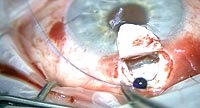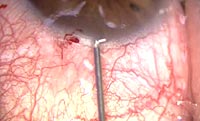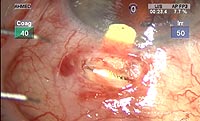Glaucoma surgical innovations explore new pathways for aqueous outflow
Alternatives to trabeculectomy are successfully lowering IOP in open-angle glaucoma patients, without a bleb or other complications associated with standard filtration surgery.
Click Here to Manage Email Alerts

The glaucoma surgical paradigm is shifting from wound healing modulation to enhancing aqueous outflow, with approaches that avoid the trabecular meshwork, reducing the need for a filtration bleb, according to clinicians.
The new methods could reduce the rate of trabeculectomy performed in open-angle glaucoma patients, while still providing IOP-lowering effects and scaling down medication use. Doing so would help limit the many complications associated with penetrating surgery, including hypotony, bleb leak, shallow anterior chamber, choroidal detachment and cataract, according to researchers.
Some new procedures and devices have been approved for use in the United States, while others are in various stages of U.S. Food and Drug Administration trials.
 Ike K. Ahmed |
In a telephone interview with Ocular Surgery News, OSN Glaucoma Section Member Ike K. Ahmed, MD, FRCSC, said improved imaging and technology have heralded the invention of additional procedures and devices for glaucoma surgery. He said new technologies are moving the glaucoma surgical paradigm closer to the “holy grail” of glaucoma treatment: reducing IOP and medication use early in the disease, with no bleb and limited complications.
“We’re changing from wound healing modulation with trabeculectomy to slow the patient’s healing down so that the bleb survives. We’re now using more physiologic methods of lowering pressure, where we don’t have to rely so much on wound healing,” Dr. Ahmed said.
 E. Randy Craven |
Researchers are also investigating therapeutic options using tube shunts, drugs and lasers in a bid to reduce or eliminate the use of blebs, E. Randy Craven, MD, said. In an interview with OSN, Dr. Craven said it is an exciting time to be treating and researching glaucoma, as clinicians and companies make strides in developing technologies that are safe and effective.
“Everyone is trying to figure out how to get the fluid out of the eye more naturally that would allow us to get the pressure down,” Dr. Craven said. “Basically, glaucoma surgeons are plumbers. We’ve got blockage everywhere, so we’re just trying to figure out how to get the fluid out.”
Bypassing the trabecular meshwork
The new procedures and devices target two separate approaches: Schlemm’s canal and the suprachoroidal space. Both avoid the traditional pathway of the trabecular meshwork used in trabeculectomy.
 Vision Blue is used during canaloplasty to assess distal outflow system. Images: Ahmed IK | ||
Approaches to lowering IOP through Schlemm’s canal have two pathways — ab externo and ab interno. These should be viewed as two distinct ways to approach trabecular bypass procedures, Dr. Ahmed said, because they require different techniques and produce different results.
“The ab externo methods seem to have better, potent IOP-lowering [effect], but a little bit more effort and risk involved,” he said. “The ab interno methods have considerably lower risk, but not as great a potency.”
While there are approved devices for both ab externo and ab interno approaches, no devices have been approved in the Unites States yet for accessing the suprachoroidal space. Several companies are developing technologies for accessing the suprachoroidal space, but none is yet commercially available, Dr. Ahmed said.
He said that within each pathway, procedures and devices differ in the degree of IOP lowered, risk of complications and skill set required. A review of indications for each approach shows the benefits and limitations of each.
Ab externo approaches
Ab externo procedures are indicated for open-angle glaucoma patients, including those at higher risk of complications with trabeculectomy, Dr. Ahmed said. Procedures and devices in this pathway typically allow for an average IOP of 12 mm Hg to 15 mm Hg, he said.
The most common ab externo procedure is canaloplasty. The procedure is a minimally invasive surgery performed with a microcatheter manufactured by iScience Interventional. It re-establishes and enhances the outflow through the juxtacanalicular trabecular meshwork into the canal, and circumferential flow from the canal to the collector channels, Dr. Ahmed said.
There is a slight risk that the procedure may have to be converted to a trabeculectomy, but overall complication rates are low. The procedure has some technical difficulty, especially in creating proper suture tension, he said.
Dr. Ahmed said he uses canaloplasty in the majority of his patients and that IOP results are similar to trabeculectomy. He still performs trabeculectomies on patients with target pressures of 11 mm Hg or lower and patients with angle-closure glaucoma.
 Richard A. Lewis |
OSN Glaucoma Section Member Richard A. Lewis, MD, and colleagues have studied canaloplasty in a prospective, nonrandomized study. In a telephone interview with OSN, Dr. Lewis said that many researchers are now examining the procedure as it gains attention for therapeutic treatment.
In their study, Dr. Lewis and colleagues looked at 147 patients with IOP higher than 21 mm Hg who were treated with canaloplasty. At 12 months follow-up, there was a qualified success in 91% of cases, meaning that IOP was less than 21 mm Hg with or without medication. Of the original patient cohort, 30% were still on medication at 1 year. Postoperative complications occurred in 11.7% of cases.
Dr. Lewis said studies such as the Tube Versus Trabeculectomy Study are demonstrating that there are alternatives to trabeculectomy that adequately lower pressure, including nonpenetrating procedures such as canaloplasty and tube shunts.
“It’s a great time to be innovating in this area,” he said. “We now have choices. We’re not just stuck doing destructive surgery.”
Ab interno approaches
Ab interno devices are indicated for open-angle glaucoma patients who have target pressures from 15 mm Hg to 18 mm Hg. The devices are typically safe, with a low risk of complications and typically little risk of having to convert to trabeculectomy during the procedure, Dr. Ahmed said.
 The iStent is inserted. |  The Solx gold shunt is placed in the suprachoroidal space. | |
However, the pressure is not lowered with the ab interno devices as much as with other pathways, he said. Only one ab interno device, the Trabectome (NeoMedix), is approved for use in the United States. According to a study of the Trabectome in 101 patients by Minckler and colleagues, 84% of patients had an overall success of IOP less than 21 mm Hg with or without medications and no subsequent surgery. Complications were limited, with nine eyes undergoing trabeculectomy. The skill set transfer is relatively easy with the device, the researchers said.
The iStent (Glaukos), another ab interno device, is currently in FDA clinical trials, and the device could be available in the United States as early as next year. Dr. Craven presented 1-year results of a 2-year multicenter study of the iStent at the American Society of Cataract and Refractive Surgery meeting in Chicago.
In the study, 53 eyes of 59 enrolled subjects completed at least 12 months of follow-up. Subjects underwent clear cornea phacoemulsification with ab interno gonioscopically guided implantation of the iStent. Subjects had a mean baseline pressure of 21.5 mm Hg, with a mean 1.7 medications used at baseline. After surgery and implantation of the device, the mean IOP was 17.4 mm Hg and mean medications used dropped to 0.6, Dr. Craven said at the meeting.
There were some complications, including seven cases of stent lumen obstruction, six cases in which the stent touched the iris and three cases in which trabeculectomy was performed.
Dr. Craven told OSN that the procedure takes a few minutes and has a slightly difficult skill set.
“This is pretty minimal and elegant and doesn’t disrupt much in the eye,” he said.
Suprachoroidal space
Procedures that utilize the suprachoroidal space should be used in patients who have a target pressure around 15 mm Hg or 16 mm Hg, Dr. Ahmed said. The suprachoroidal space appears to be an excellent pathway option for those patients who had had failed trabeculectomy or Schlemm’s canal procedures, he said, and skill transfer is relatively easy in the devices that are under development.
 Jason Bacharach |
The Solx gold shunt is probably about a year away from approval in the United States, according to Jason Bacharach, MD, a clinical investigator for both the iStent and the gold shunt devices.
He said the gold shunt GMS Plus has shown good IOP-lowering effects in failed glaucoma surgical cases in early clinical data. The device appears safe with few complications, he said.
Dr. Bacharach told OSN that when the devices are ultimately approved, physicians will have more ways of treating glaucoma patients without blebs and complications.
“I think they’re going to offer quicker recuperation periods and better therapeutic options for surgical physicians,” he said.
For more information:
- Ike K. Ahmed, MD, FRCSC, can be reached at Credit Valley EyeCare, 3200 Erin Mills Parkway, Unit 1, Mississauga, Ontario L5L 1W8, Canada; 905-820-6789; fax: 905-820-0111; e-mail: ike.ahmed@utoronto.ca. Dr. Ahmed is a consultant to iScience, Solx and Glaukos.
- Jason Bacharach, MD, can be reached at 104 Lynch Creek Way, Petaluma, CA 94954; 707-762-3573; e-mail: jbacharach@northbayeye.com. Dr. Bacharach is an investigator for Glaukos and Solx.
- E. Randy Craven, MD, can be reached at Glaucoma Consultants of Colorado, 26 W. Dry Creek Circle, #225, Littleton, CO 80120; 303-797-1900; fax: 303-347-1341; e-mail: ercraven@glaucdocs.com. Dr. Craven is an investigator for Glaukos.
- Richard A. Lewis, MD, can be reached at 1515 River Park Drive, Sacramento, CA 95815; 916-649-1515; fax: 916-649-1516; e-mail: rlewiseyemd@yahoo.com. Dr. Lewis is a consultant for iScience Interventional.
- Glaukos, maker of the iStent, can be reached at 26051 Merit Circle, Suite 103, Laguna Hills, CA 92653; 949-367-9600; Web site: www.glaukos.com. iScience Interventional, maker of the iCath ASAT, can be reached at 4055 Campbell Ave., Menlo Park, CA 94025; 888-846-4724; Web site: www.iscienceinterventional.com. NeoMedix, maker of the Trabectome, can be reached at 15042 Parkway Loop, Suite A, Tustin, CA 92780; 714-258-8355; Web site: www.neomedix.net. Solx, maker of the Gold Shunt, can be reached at 890 Winter St., Waltham, MA 02451; 800-939-7659; Web site: www.solx.com.
References:
- Gedde SJ, Herndon LW, et al. Surgical complications in the Tube Versus Trabeculectomy Study during the first year of follow-up. Am J Ophthalmol. 2007;143(1):23-31.
- Lewis RA, von Wolff K, et al. Canaloplasty: circumferential viscodilation and tensioning of Schlemm’s canal using a flexible microcatheter for the treatment of open-angle glaucoma in adults: Interim clinical study analysis. J Cataract Refract Surg. 2007;33(7):1217-1226.
- Minckler D, Baerveldt G, et al. Clinical results with the Trabectome, a novel surgical device for treatment of open-angle glaucoma. Trans Am Ophthalmol Soc. 2006;104:40-50.
- Erin L. Boyle is an OSN Staff Writer who covers all aspects of ophthalmology.
